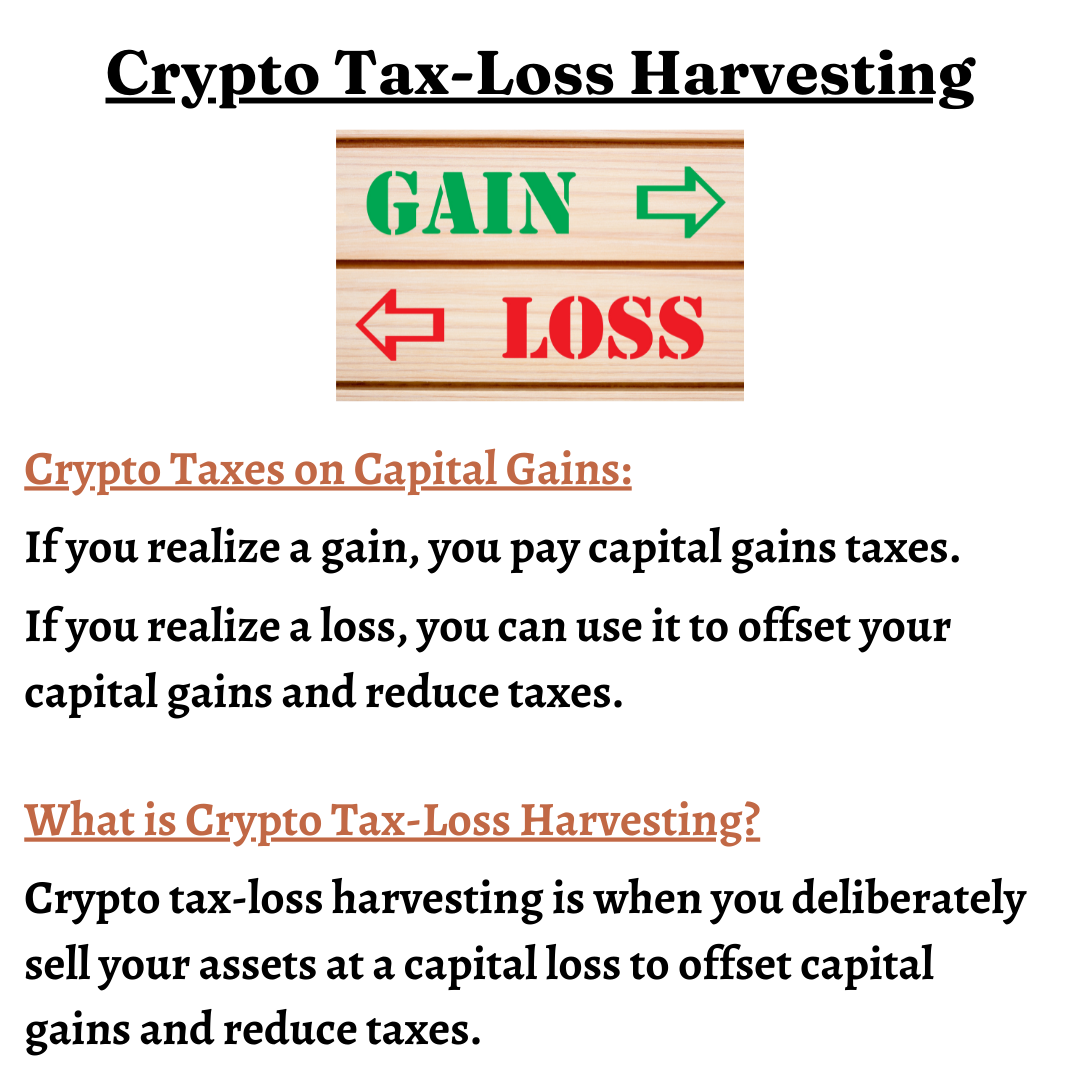Crypto Tax Loss Harvesting – Save More Taxes
The IRS is relentlessly going after people not paying taxes on their crypto gains. But as long as you pay all your taxes on time, you don’t have anything to worry about. However, let’s admit it. Paying taxes is no fun. Taxpayers are constantly looking for ways to reduce their taxes and save more money. And one of the many ways they do this is with crypto tax loss harvesting.
In this article, we will talk all about crypto tax loss harvesting, how to harvest loss the right way, the limitations, and risks associated with it, and some common problems people face.
But before all that, let’s find out what tax loss harvesting is and how it works in cryptocurrency.
What is Tax Loss Harvesting?
We already know how crypto taxes work.
When you sell your assets for more than their cost basis (the price you bought them for), you realize a capital gain. And when you realize capital gains, you pay capital gains taxes.
But on the other hand, when you sell your assets for less than their cost basis, you realize a capital loss. Now you can use this capital loss to offset the other capital gains and reduce taxes.
Tax-loss harvesting is a tax-saving strategy where you, as a taxpayer, deliberately sell your assets at a capital loss to offset capital gains and reduce taxes. It’s a perfectly legal and ethical way to save more taxes.

Also worth mentioning, you can use your capital losses on crypto to offset capital gains on other assets like stocks and vice versa.
Example of a Crypto Tax Loss Harvesting Scenario
Suppose you bought 2 Bitcoins for $5000 and 5 Ethereum for $9000 in 2019.
Two years later, you sell the 2 BTC for $8000, realizing a capital gain of $3000.
At the same time, the 5 ETH you bought has now depreciated in value and is priced at $8000.
Now, you can go one of two ways.
You hold those 5 ETH and pay taxes on the realized capital gain of $3000.
You sell those 5 ETH, realizing a capital loss of $1000 that you use to offset your capital gains. Hence, paying taxes on only $2000, instead of $3000.
Is There Any Limit to Tax Loss Harvesting?
No. There is no limit on how much loss you can harvest.
You can harvest as much as you want and offset up to 100% of your capital gains. Any remaining amount can be used to deduct up to $3000 from your ordinary income to reduce income taxes.
Any remaining losses after that will roll over to the next tax year.
How to Harvest Crypto Tax Losses the Right Way?
Tax loss harvesting is a tax-saving strategy that people use to reduce their overall taxes. And like any other strategy, there is a right way to do it where you get the most out of it, and a wrong way where you lose more than you gain.
Ideally, you should consult a tax professional to help you out with the strategy. But overall, the following is a quick brief of how to get the most out of it.
The Deadline for Tax Loss Harvesting
First and foremost, we need to understand the importance of the deadline.
If you want to harvest any tax loss on your crypto, you must do it before the end of the tax year, which is Dec 31, even though the actual tax filing process can last up to April 15 of next year.
So, make sure you sell your cryptocurrencies sitting at a loss before the end of the year, or they will roll over to the next tax year.
When to Harvest Crypto Tax Loss?
This is a very tricky question, and there is no one size fits all answer for it.
Usually, people wait till the end of the year to sell their cryptos, sitting at a loss. Given the right circumstances, it could be a great strategy. But mostly, it’s not.
A better strategy to approach this situation is to sell your crypto anytime during the year when there is a major dip in prices. Since crypto prices are very volatile, you might miss opportunities to harvest larger losses if you wait till the end of the year.
For example, suppose you have 5 ETH you bought for $9000. During the month of August, its price falls down to $4000, but you don’t sell it. In December, when you finally decide to sell it and harvest some losses, the prices have risen to $8000.
If you had sold those ETH in August, you would have harvested $5000 in capital losses that you could have used to deduct your capital gains or ordinary income. But now, you’re left with only $1000 in capital losses.
Now, of course, if you haven’t realized a lot of capital gains, this strategy might not be the best for you. So, it all depends on your individual circumstances and context. That’s why it’s best to consult a tax professional to look at your case individually and devise a strategy accordingly.
What is the Wash Sale Rule in Crypto?
Wash sale refers to the practice when an investor sells their asset for a loss to get tax benefits but then quickly buys the same or a similar asset right after. Other variations include buying the same or similar asset before selling the actual one. Either way, the results remain the same – the taxpayer gets to keep their assets while also saving taxes at the same time.
The IRS has a wash sale rule in place to prevent investors from exploiting this loophole. The rule implies that you can’t claim losses for tax benefits if you sell an asset and buy back the same or any similar asset 30 days before or after the sale.
However, as of now, the wash sale rule only applies to security, and as we all know, cryptocurrencies are considered property by the IRS. Therefore, the wash sale rule doesn’t apply to crypto.
What if you Bought the Same Crypto at Multiple Price Points?

This seems like a very complex situation on the surface but really isn’t. To understand how it works, let’s look at an example –
You buy 2 BTC in April for $5000 – You buy another 2 BTC in August, this time for $8000 – In November, you sell 2 BTC for a loss of $2000 – What is your capital loss?
The solution to this problem lies in what accounting method you choose for this transaction. Generally, most US taxpayers use the first-in-first-out (FIFO) method to calculate capital gains and losses. It basically means that you’ll count the sales of the BTC in the order you bought it.
So, in the example, your capital loss would be $3000 because you bought the first set of BTC for $5000.
However, other accounting methods like last-in-first-out (LIFO) and highest-in-first-out (HIFO) also do exist. But to use these methods, you’re required to identify specific cryptos that you’re buying and selling.
When Crypto Tax Loss Harvesting is Not Worth it
The only time tax loss harvesting is not worth it is when the cost of harvesting losses is more than what you save on taxes. It can happen in many ways.
Exchange fees are a big one. In the process of harvesting losses, you might have to do some transactions on crypto exchanges that require fees. In that process, if you spend more than what you save, it’s usually not worth it.
Some other scenarios are when you sell crypto for a much smaller loss than what you would have got if you waited for a bigger price dip. Similarly, you might not wanna harvest loss to offset long-term capital gains where the tax rate is basically zero or so low that it’s not worth the extra time, energy and money.
There are many such scenarios where tax-loss harvesting may do more harm than good. It’s impossible to list them all. Once again, that is why it’s best if you consult with a tax professional.
How Bitcoin.Tax Can Help you in Crypto Tax Loss Harvesting
It’s very difficult to gather and calculate all your cost basis, capital gains, losses and other transaction details, especially when you’re using multiple wallets and exchanges.
Bitcoin.Tax does all the work for you. All you have to do is connect your wallets and exchange accounts with our software and it will automatically gather all transaction data and calculate your taxes. It will even show you how much tax loss you have harvested.